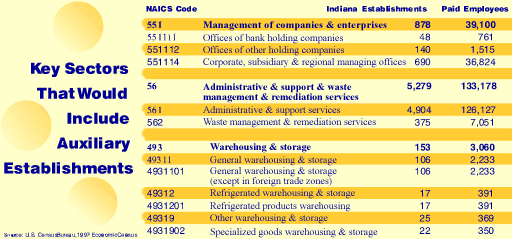NAICS Tres: A Look at Auxiliary Establishments
Third in the NAICS Series
The Great Depression of the 1930s spawned many new federal mechanisms for tracking the economy. One of those was the Standard Industrial Classification (SIC) system, developed when manufacturing was the dominant industry. While there were many modifications to the SIC over the years, by the 1990s it was clear that the major shifts in the American economy mandated major change in how its industries were classified. The result: NAICS, the North American Industry Classification System.
The changes in establishment classification were big, creating twenty industry groups under NAICS where there were eleven under the SIC system. The previous two issues of IN Context covered the major changes. This time we take a brief look at how the classification of auxiliaries and corporate offices has changed between the two systems.
What is an auxiliary establishment, anyway? It is an establishment that primarily provides support services for an enterprise or company that has multiple establishments under common ownership or control. Under SIC, such auxiliary establishments were classified according to the primary activity of the enterprise they served. With NAICS, auxiliary establishments are classified according to the primary activity of the auxiliary itself. So, if an auxiliary is providing data processing for an auto manufacturer, that auxiliary establishment will be classified under data processing (NAICS 51421). Another significant change in NAICS is that of establishments that are the head offices of an enterprise. These are now classified in the new NAICS industry 551114, Corporate, Subsidiary and Regional Managing Offices.
Such changes will result in significant shifts in industry-based employment data. In 1992, economic census data showed more than 1,000,000 auxiliary employees assigned to manufacturing and over 840,000 auxiliary employees assigned to retail trade. These employees are most likely to move to one or more of the following sectors or sub-sectors:
- Management of Companies and Enterprises
- Administrative Support, Waste Management and Remediation Services
- Warehousing and Storage
- Computer Systems Design and Related Services
- Accounting, Tax Preparation, Bookkeeping and Payroll Services

